#Larry Dolgin
Explore tagged Tumblr posts
Text
Top Line (1988)
Top Line (1988) #Critique #TopLine #FrancoNero
Résumé : L’auteur Ted Angelo découvre un vaisseau extraterrestre dans la jungle colombienne. Lorsqu’il tente d’en avertir le monde, il vit une aventure plus grande que nature alors qu’il est chassé par plusieurs organisations, incluant le KGB et la CIA, qui tentent de maintenir ce secret enfoui pour toujours.
Critique :
Malheureusement pour vous, cette critique va contenir quelques détails…
View On WordPress
#Deborah Moore#Franco Nero#George Kennedy#Larry Dolgin#Mary Stavin#Nello Rossati#Robert Redcross#Roberto Gianviti#Rodrigo Obregón#Shirley Hernandez#Steven Luotto#William Berger
0 notes
Text
Kdo najde přítele, najde poklad
Oba vyvedení parťáci se tentokrát vydávají na údajně liduprázdný ostrov, na němž má být ukrytý poklad. K jejich překvapení ostrov není opuštěný, o čemž je dostatečně přesvědčí střelba, při níž jde oběma o život. Kromě domorodců na ostrově žije zapomenutý japonský voják, stále v plné válečné pohotovosti. Společnými silami se vydají hledat záhadný poklad, čelí útoku pirátů, až nakonec dojdou k vytouženému cíli.
youtube
Kdo najde přítele, najde poklad was originally published on Kritiky.cz
#Bud Spencer#Giovanni Cianfriglia#John Fujioka#Larry Dolgin#Louise Bennett#Ottaviano Dell'Acqua#Riccardo Pizzuti#Roberto Messina#Sal Borgese#Terence Hill
0 notes
Text

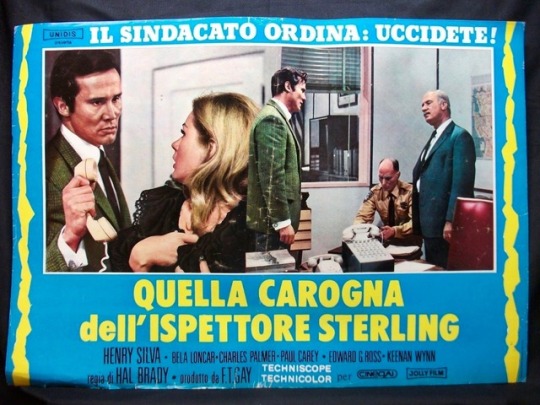
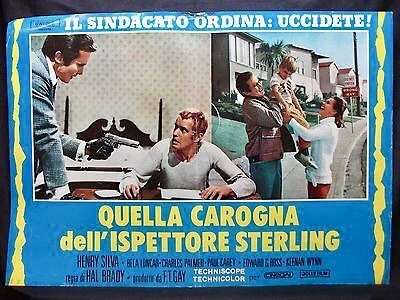

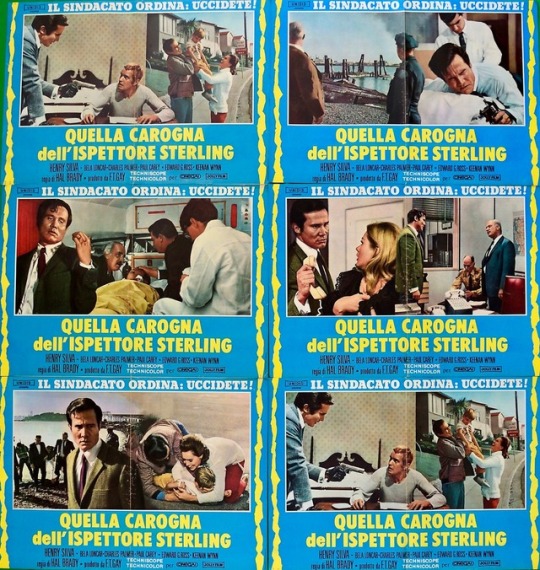
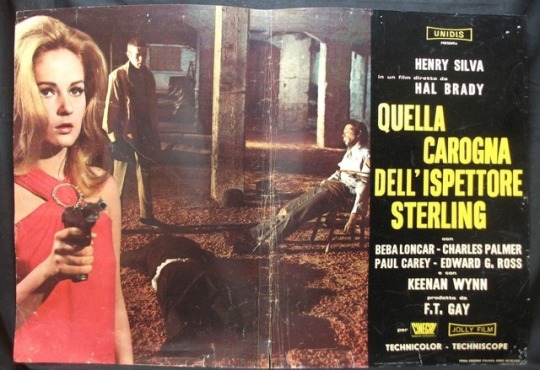
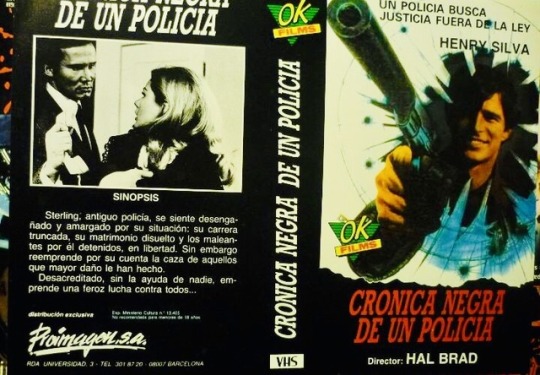
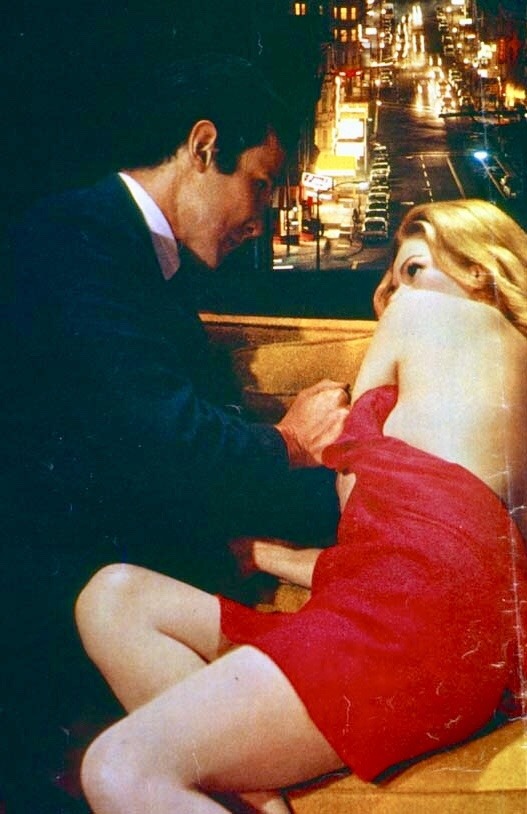


1968
Quella carogna dell'ispettore Sterling
Also Known As (AKA)
(original title) Quella carogna dell'ispettore Sterling
Denmark Sterling
France Ce Salaud d'inspecteur Sterling
Greece (transliterated) O enohos
Ireland (English title) Falling Man
Norway Inspektør Sterling
Portugal A Ratoeira
Spain Crónica negra de un policía
Sweden Mannen, lagen och våldet
USA (reissue title) The Falling Man
USA Frame up
Uruguay (original subtitled version) Intriga mortal
Yugoslavia (Serbian title) (literal title) Onemogucite inspektora Sterlinga
Frame Up
Release Dates
Italy 13 April 1968
France 7 August 1968
Sweden 31 August 1969
Denmark 17 October 1969
Portugal 4 December 1969
Norway 19 May 1970 (Oslo)
Uruguay 30 July 1970
Directed by
Emilio P. Miraglia ... (as Hal Brady)
Music by Robby Poitevin
Writing Credits
Max Hatired ... (writer)
Dean Maurey ... (writer)
Technical specifications
Runtime 1 hr 35 min (95 min)
Cast
Henrys Silva... Inspector Sterling
Beba Loncar... Janet
Keenan Wynn... Inspector Donald
Carlo Palmucci... Gary (as Charles Palmer)
Pier Paolo Capponi ... O'Neil (as Paul Carey)
Luciano Rossi ... Randolph (as Edward G. Ross)
Larry Dolgin ... Kelly
Charlene Polite ... Anne
Roberto Maldera... Rocky (as Bob Molden)
Lella Cattaneo ... Woman at Hotel (uncredited)
Bill Vanders ... Hotel Manager (uncredited) #quellacarognadellispettoresterling #frameup #emiliopmiraglia #emiliomiraglia #henrysilva #bebaloncar #lucianorossi #pierpaolocapponi #poliziottesco #poliziotteschi #poliziottescostyle
#quella carogna dell’ispettore sterling#frame up#emilio miraglia#emilio p miraglia#beba loncar#henry silva#luciano rossi#pier paolo capponi#poliziotteschi#poliziottesco#giallo fever#giallofever#italian cult#italian giallo#cinema cult#cult#gialli#international cult#giallo
7 notes
·
View notes
Text
Treating Sleep Apnea with Pills Instead of Machines
The following article Treating Sleep Apnea with Pills Instead of Machines was first published to Elly Mackay's Sleep Blog
The disorder has several different causes, researchers are learning. That finding opens the door for personalized therapies—and perhaps even effective drugs.
By Elie Dolgin, Knowable Magazine
Published by Knowable Magazine on 4.29.2020
My wife’s father, like many who suffer from restless sleep, was long in denial. For years he has slumbered in fits and starts, drifting off at all hours of the day and never getting a good night’s rest. Still, he refused to get tested for obstructive sleep apnea, in which interrupted breathing causes frequent waking.
In spite of persistent urging from his daughter, a physician, my father-in-law didn’t see the point because the only treatment proven to reverse the breathing problems responsible for sleep apnea is a ventilator called a CPAP machine — and he was adamantly opposed to strapping a mask to his face and wearing bulky headgear while he snoozed. “I won’t go to bed looking like Dracula,” he told me.
Soon he might not have to, if some of the latest research findings bear out. Sleep apnea, clinicians are learning, has not just one cause, but several — and drugs exist that can target most of them. With this new knowledge, there’s a real possibility that some of the billion or so people across the world who suffer from the sleep disorder may soon be able to take medications instead of having to rely on cumbersome devices.
It won’t be a one-size-fits-all cure, but it would be better than what’s currently available on the pharmacy shelf for apnea sufferers: drugs that do little more than boost alertness to overcome the grogginess that comes from not getting enough quality sleep. “If there was a pill for sleep apnea that was safe and effective, I think everybody would try it,” says Luigi Taranto Montemurro, a pulmonologist and sleep medicine doctor at Brigham and Women’s Hospital in Boston.
That remains a big “if.” Dozens of drugs have been tested for their ability to reduce airway obstruction. Nearly all have failed. As recently as 2019, Thomas Gaisl and his colleagues from the University of Zürich wrote in a systematic review of drug studies in the field: “There is currently insufficient evidence to recommend any pharmacotherapy” for sleep apnea.
That may be because trials have generally treated people with sleep apnea as a monolithic group. But now, with the emerging bespoke approach to disease management, experts say a new era of individualized drug therapy should dawn for people who rebuff CPAP and other wearable devices — which is to say, people like my father-in-law. He, in the face of sustained pestering to visit a sleep lab, finally relented and received an official diagnosis of mild apnea. Now he is waiting for researchers to prove that a drug can address the root causes of his particular breathing issues.
“It’s a story of personalized medicine,” says Jan Hedner, a sleep specialist at the University of Gothenburg in Sweden.
Divide and Conquer
Clinicians have long been aware that a variety of physiological disturbances can lead to sleep apnea, but it wasn’t until roughly a decade ago that they came up with a practical way to turn that knowledge into a clinically useful diagnostic. In 2011, Andrew Wellman and his coworkers at the Harvard Sleep Disordered Breathing Laboratory described a system for classifying the cause of an individual’s disease according to four factors that contribute, singly or in combination, to sleep apnea.
The first is the tendency of the airway in the throat to collapse during sleep, usually due to a narrowing of the passage. All people with sleep apnea show some degree of airway narrowing, but the severity varies widely between individuals. In 2013, Wellman and his colleague Danny Eckert, a sleep physiologist now at Flinders University in Australia, showed that airway collapsibility was the main trigger of apnea in approximately 45 percent of patients. For the remaining individuals, though, non-anatomical features — impaired muscle activity during sleep, a low threshold for waking or unstable breathing control — played a more important role.
Each of these physiological factors involves a different aspect of sleep or respiratory biology, notes Gaisl, so each will have a different drug target. “The disease is actually a conglomerate of many different disorders that have to be treated differently,” he says.
Although most patients show some combination of these factors, Wellman and his collaborators showed that they could grade individuals according to the severity of each defect and identify which factors were likely most important for each patient. This new understanding, they argued, helps explain why many earlier drug trials had failed. The medicines weren’t all bad — they had just been tested on all-comers with sleep apnea, rather than only in those people whose physiology suggested that they stood a chance of benefitting.
Take eszopiclone, a sedative sold under the brand name Lunesta and typically used to treat insomnia. An initial trial conducted in the mid-2000s found that the therapy was no better than a placebo at limiting apnea-related events. However, a follow-up study from the Harvard team demonstrated that the drug in fact had a beneficial effect; it just worked only for those patients with low arousal thresholds. That subset of patients stood to gain from being put into a deeper sleep, which prevented them from stirring at the slightest narrowing of the airways.
The researchers later came to a similar conclusion about a psychiatric drug called desipramine. The first-generation antidepressant had little effect on sleep apnea in the study population as a whole, but it did alleviate symptoms among patients with limited muscle function in their airways, presumably because the drug’s effects on nerve signaling led to enhanced activity of muscles in the tongue and throat.
In a literature review published late last year, Wellman and Taranto Montemurro — together with one of Eckert’s PhD students, Ludovico Messineo — hypothesized that other therapies now in clinical testing may similarly work only for subgroups of patients. Indeed, the latest drug trial that they led, involving two drugs that improve control of tongue muscles, provides some of the strongest evidence to date.
The study was small and short — just 20 participants, just two nights of sleep tracking — but the results were dramatic. On the night that participants took placebo pills, they endured an average of 28.5 airway blockages per hour. With the drug combo, the hourly average number of obstructive episodes dropped to 7.5. Fewer than five is considered normal — and one man who entered the trial with severe apnea, meaning he experienced more than 30 events per hour, saw his frequency of respiratory stoppages go to just two per hour on the therapy.
“I’ve never seen anything like that,” Taranto Montemurro says. “It was one of the best moments of my career when I saw people breathing normally.”
After-the-fact analyses on the study subjects — who had not been prescreened for particular drivers of sleep apnea — revealed that participants with stiffer airways, a sign of milder anatomical defects, responded best to the therapy, consistent with the researchers’ predictions. “With this phenotyping theory,” says Taranto Montemurro, “we can actually identify why some patients get better and some do not.”
Three years ago, he and Wellman teamed up with biotech entrepreneur Larry Miller and launched a new company, Apnimed, to advance the drug combination further. The startup has since completed a 140-person study, one of the largest ever for a sleep apnea therapeutic, involving the same two medicines given for up to nine nights in a row. (The company is also evaluating several other drug combinations in smaller ongoing exploratory trials.)
Miller declined to discuss full outcome data from the 140-person trial, but he says the results are “very encouraging”—and notably, there was an identifiable subset of patients with what he called “responsive airways” who experienced the greatest benefit from the drug therapy. By building upon and adapting the Harvard team’s model, “we have a good algorithm for identifying likely responders,” Miller says, adding: “We’re feeling pretty good about our prospects” for clinical success.
To definitively prove the value of their drug-personalization strategy, though, Wellman and Taranto Montemurro would need to assign patients ahead of time to drugs that match their type of apnea, something they have not yet done.
Hard Pill to Swallow?
Not everyone shares such a rosy view about the immediate prospects for drugs. Diane Lim, a sleep specialist at the Corporal Michael J. Crescenz VA Medical Center in Philadelphia, says that she is rooting for drug developers like Apnimed and that she is “more hopeful today” than ever that the research is on the right path. But, she points out, the quest for a pharmaceutical solution to sleep apnea is decades-old, “and we still haven’t seen an effective drug.”
In 2017, Lim wrote an article on current sleep apnea management in the Annual Review of Medicine. Like the Harvard team, she and coauthor Allan Pack, director of the University of Pennsylvania’s Center for Sleep and Circadian Neurobiology, argue for an individualized approach to diagnosis and treatment. But to them, that means better defining sleep apnea subtypes and then making the most of existing treatment options.
Beyond CPAP, available devices include mouth-guard–like instruments that open up the airways by moving the lower jaw forward and implantable nerve stimulators that jolt the tongue muscles to keep them from sagging into the throat. Weight loss also helps in many cases. “So, if you get a diagnosis of sleep apnea, it doesn’t mean that you are tied to the CPAP,” Lim says. “There are so many options these days.” And by learning more about how different apnea subtypes respond to different proven interventions, “we will be able to better tailor treatment for each individual,” she adds.
No other device may work as well for everybody as CPAP, but many patients prefer the convenience or comfort of the alternatives. And importantly, all devices on the market are backed by concrete clinical data showing they are safe and effective — whereas with drugs, despite some promising preliminary findings, “we’re not quite there now,” Lim says.
Still, as researchers continue their pursuit, personalized drug treatments might not be that far off. And they couldn’t come soon enough for some patients.
Jason, a Bostonian in his late 40s, had battled sleep apnea for more than 15 years, during which time he underwent surgery to remove tissue in his throat and tried various devices and sleeping pills, all to still feel exhausted each morning. Then, two years ago, he signed up to receive the Harvard team’s experimental drug combination as part of a pilot study evaluating the effects of a full week of treatment.
For seven days, he forwent the CPAP, set aside the mouth guard, swore off the Ambien and simply popped two experimental pills each night before going to bed. It worked. “I generally don’t get recuperative sleep,” says Jason, who requested his last name not be used. “But when I took this medicine and I woke up, I would feel a little more refreshed.” As an added bonus: His wife, in the bed next to him, slept better as well.
But after finishing the study, Jason no longer had access to the experimental drugs, and he was forced to start again with the mouth guard—a device he describes as painful, uncomfortable and only marginally beneficial. “And that’s sort of where I am,” Jason says. Like many people with sleep apnea, including my father-in-law, he can only wait and hope.
10.1146/knowable-042820-1
Elie Dolgin is a science journalist in Somerville, Massachusetts, and a noodge of a son-in-law.
This article originally appeared in Knowable Magazine, an independent journalistic endeavor from Annual Reviews. Sign up for the newsletter.
from Sleep Review https://www.sleepreviewmag.com/sleep-treatments/pharmaceuticals/emerging-compounds/treating-sleep-apnea-with-pills-instead-of-machines/
from Elly Mackay - Feed https://www.ellymackay.com/2020/05/04/treating-sleep-apnea-with-pills-instead-of-machines/
0 notes
Text

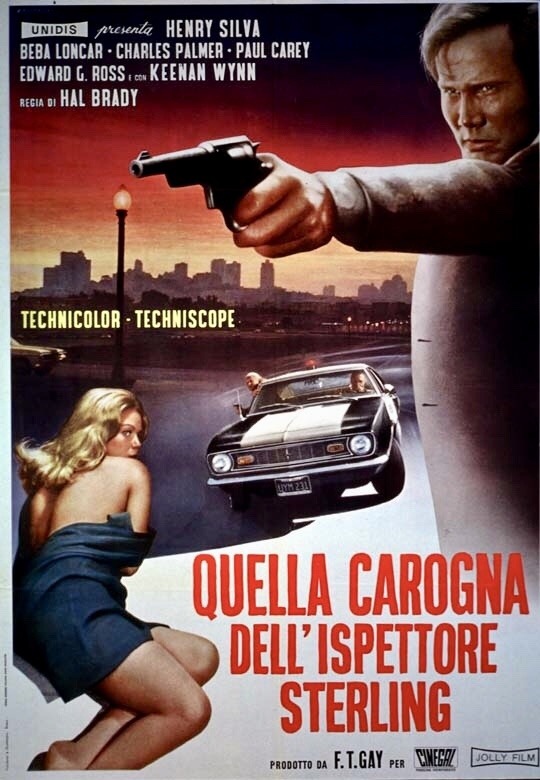
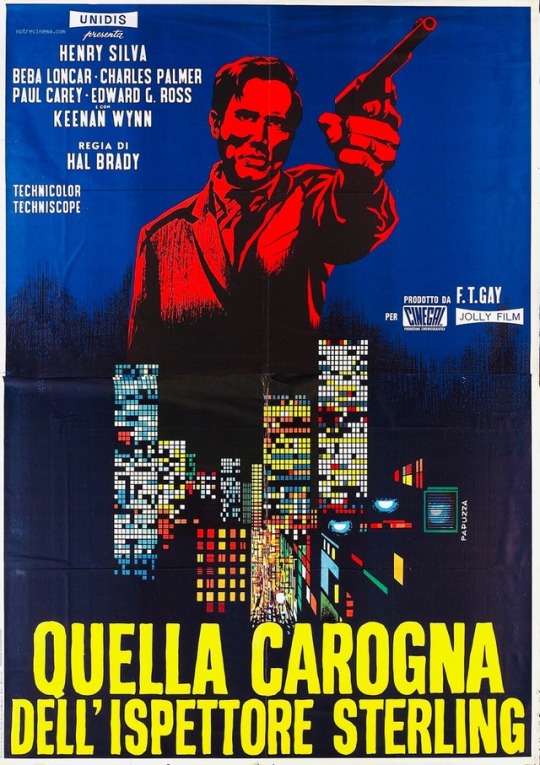
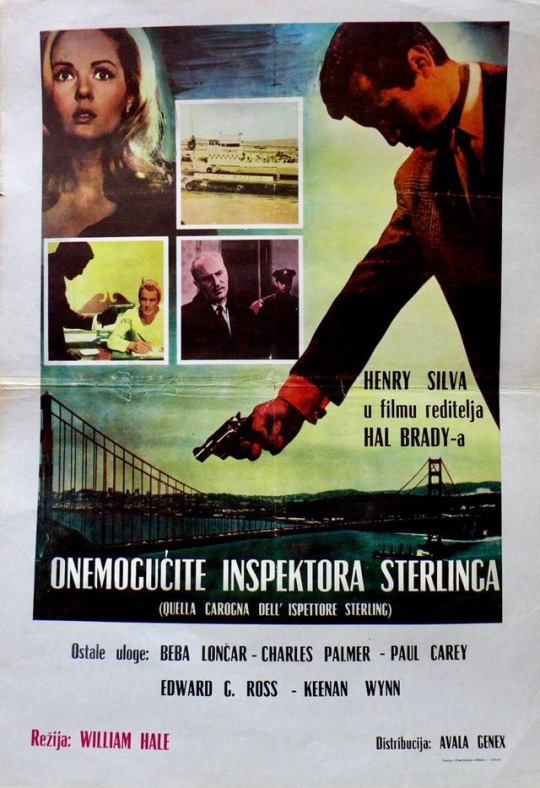
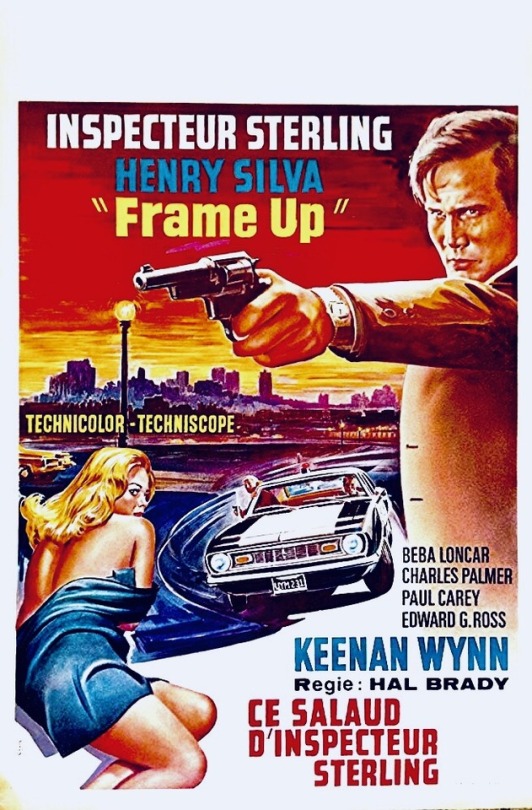

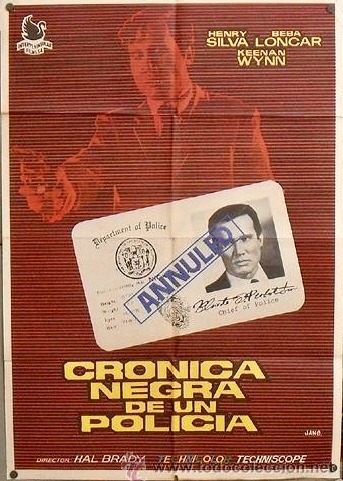
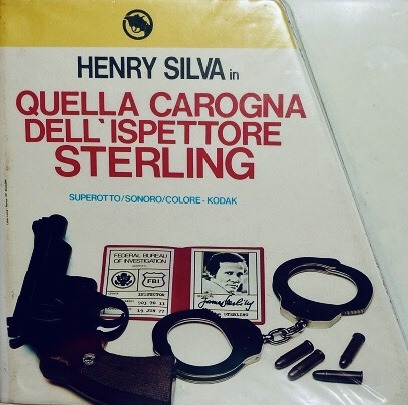
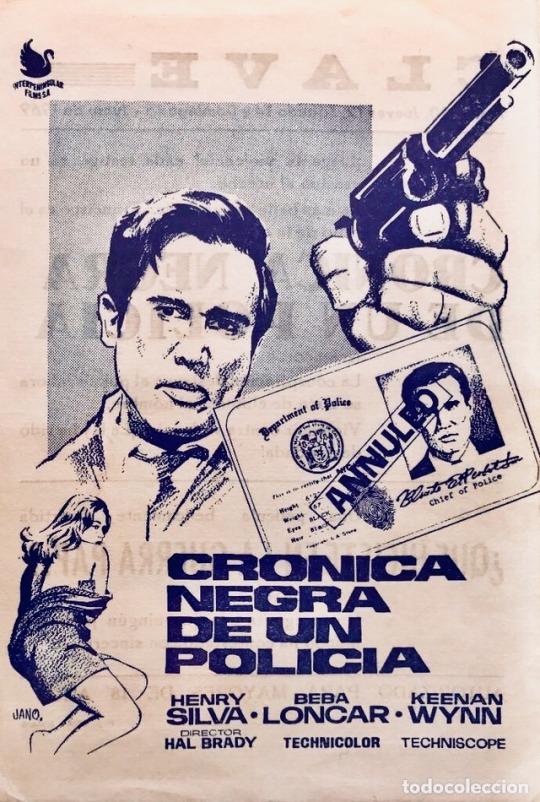
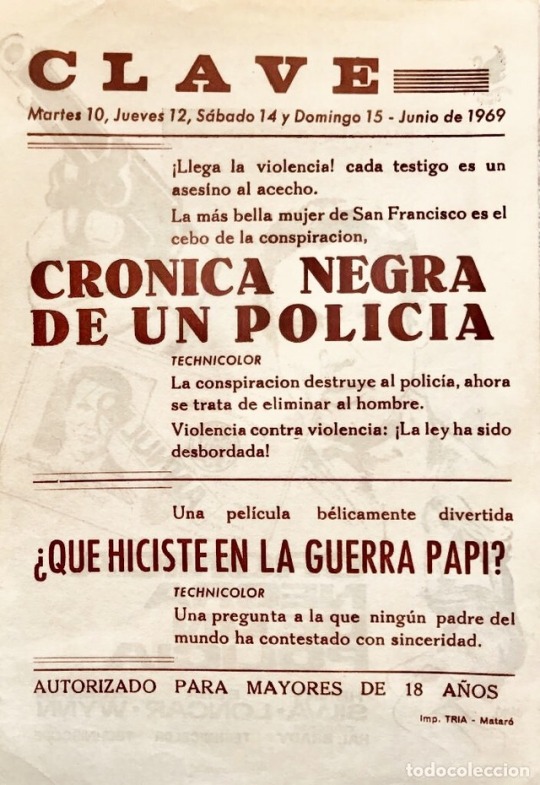
1968
Quella carogna dell'ispettore Sterling
Also Known As (AKA)
(original title) Quella carogna dell'ispettore Sterling
Denmark Sterling
France Ce Salaud d'inspecteur Sterling
Greece (transliterated) O enohos
Ireland (English title) Falling Man
Norway Inspektør Sterling
Portugal A Ratoeira
Spain Crónica negra de un policía
Sweden Mannen, lagen och våldet
USA (reissue title) The Falling Man
USA Frame up
Uruguay (original subtitled version) Intriga mortal
Yugoslavia (Serbian title) (literal title) Onemogucite inspektora Sterlinga
Frame Up
Release Dates
Italy 13 April 1968
France 7 August 1968
Sweden 31 August 1969
Denmark 17 October 1969
Portugal 4 December 1969
Norway 19 May 1970 (Oslo)
Uruguay 30 July 1970
Directed by
Emilio P. Miraglia ... (as Hal Brady)
Music by Robby Poitevin
Writing Credits
Max Hatired ... (writer)
Dean Maurey ... (writer)
Technical specifications
Runtime 1 hr 35 min (95 min)
Cast
Henrys Silva... Inspector Sterling
Beba Loncar... Janet
Keenan Wynn... Inspector Donald
Carlo Palmucci... Gary (as Charles Palmer)
Pier Paolo Capponi ... O'Neil (as Paul Carey)
Luciano Rossi ... Randolph (as Edward G. Ross)
Larry Dolgin ... Kelly
Charlene Polite ... Anne
Roberto Maldera... Rocky (as Bob Molden)
Lella Cattaneo ... Woman at Hotel (uncredited)
Bill Vanders ... Hotel Manager (uncredited) #quellacarognadellispettoresterling #frameup #emiliopmiraglia #emiliomiraglia #henrysilva #bebaloncar #lucianorossi #pierpaolocapponi #poliziottesco #poliziotteschi #poliziottescostyle
#quella carogna dell’ispettore sterling#frame up#emilio p miraglia#emilio miraglia#henry silva#beba loncar#luciano rossi#pier paolo capponi#poliziotteschi#poliziottesco#giallo fever#giallofever#italian cult#italian giallo#cult#gialli#giallo#cinema cult#international cult
2 notes
·
View notes
Photo

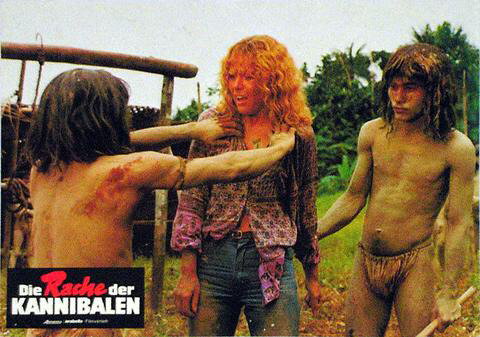
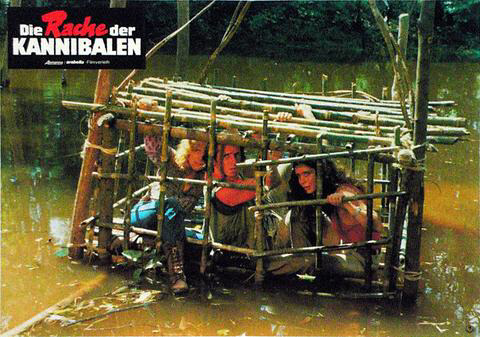



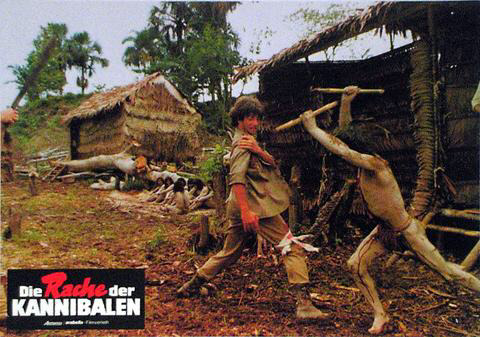
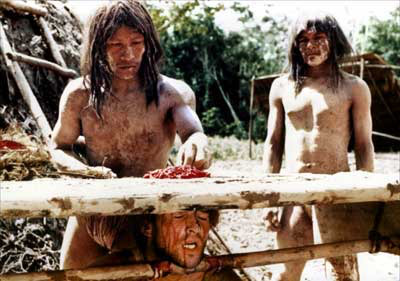


Rare German Promo Post Cards & on set shots 1981 Cannibal ferox Also Known As (AKA) Argentina Los últimos canibales Australia Woman from Deep River Brazil Canibal Ferox Czech Republic (DVD title) Zeny od hluboké reky Germany (rerun title) Im Dschungel der Menschenfresser Denmark Jaget af kannibaler Spain Caníbal feroz France Cannibal ferox France (video box title) Terreur cannibale Greece (video title) Argos thanatos Greece (transliterated) Lefki sarka sta dontia tous Greece (DVD title) Na pethanoun arga Greece Αργός Θάνατος Japan Hitokui zoku Mexico En el Infierno Caníbal Netherlands (informal literal title) De kannibalen vallen aan! Peru Hazlos morir lentamente Poland (video box title) Cannibal ferox: Niech umieraja powoli Poland (video title) Kanibale Portugal Caníbal Feroz Sweden Cannibal Ferox Slovenia Ljudozerci Amazonke Soviet Union (Russian title) Каннибалы USA Cannibal Ferox USA (alternative title) Make Them Die Slowly West Germany Die Rache der Kannibalen Directed by Umberto Lenzi Music by Roberto Donati .. (as Budy) Fiamma Maglione ... (as Maglione) Writing Credits #UmbertoLenzi ... (story) Umberto Lenzi ... (screenplay) Release Dates Italy 24 April 1981 West Germany 31 July 1981 Hong Kong 30 October 1981 Spain 7 December 1981 (Barcelona) Portugal 13 January 1982 France 16 June 1982 Australia 23 September 1982 Spain 27 September 1982 (Madrid) Netherlands 20 January 1983 USA 23 September 1983 (New York City, New York) USA 10 November 1983 Denmark 26 December 1983 Japan June 1988 USA 15 February 1997 (re-release) Czech Republic 25 January 2003 (Febio Film Festival) Cast (in credits order) Giovanni Lombardo Radice Giovanni Lombardo Radice / John Morghen ... Mike Logan (as John Morghen) Lorraine De Selle Lorraine De Selle ... Gloria Davis Danilo Mattei Danilo Mattei ... Rudy Davis (as Bryan Redford) Zora Kerova Zora Kerova ... Pat Johnson (as Zora Kerowa) Walter Lucchini Walter Lucchini ... Joe Costolani (as Walter Lloyd) Fiamma Maglione Fiamma Maglione ... Myrna Stenn (as Meg Fleming) Robert Kerman Robert Kerman ... Lt. Rizzo John Bartha John Bartha ... Mafioso Venantino Venantini Venantino Venantini ... Sgt. Ross 'El Indio' Rincon 'El Indio' Rincon ... Juanito Rest of cast listed alphabetically: Giovanni Bergamini Giovanni Bergamini ... Clerk (uncredited) Lewis E. Ciannelli Lewis E. Ciannelli ... Ross (voice) (uncredited) Larry Dolgin Larry Dolgin ... Paul (voice) (uncredited) Anthony La Penna Anthony La Penna ... Wilson (voice) (uncredited) Andy Luotto Andy Luotto ... Joe (voice) (uncredited) Steven Luotto Steven Luotto ... Tim (voice) (uncredited) Edward Mannix Edward Mannix ... Rizzo (voice) (uncredited) Richard McNamara Richard McNamara ... Hood (voice) (uncredited) Riccardo Petrazzi Riccardo Petrazzi ... Hunter (uncredited) Perry Pirkanen Perry Pirkanen ... Paul (uncredited) Dominic Raacke Dominic Raacke ... Tim (uncredited) Ted Rusoff Ted Rusoff ... technical specifications Runtime 1 hr 33 min (93 min) 1 hr 25 min (85 min) (heavily cut) (South Korea) 1 hr 26 min (86 min) (heavily cut) (UK) Filming Locations Amazon Rainforest, Colombia Leticia, Amazonas, Colombia Chinatown, Manhattan, New York City USA New York City, New York, USA RPA - Elios Studios, Rome, Lazio, Italy (studio)
#cannibal ferox#cannibalferox#umberto lenzi#umbertolenzi#cannibal film#cannibalism#cannibal corpse#canibal ferox#los ultimos canibales#giovanni lombardo radice#lorraine de selle#venantino venantini#venantinovenantini#giallo fever#giallofever#gialli#giallo#italian giallo#international cult#cult#italian cult#cinema cult#cannibal movies#banned movie#movie banned
23 notes
·
View notes
Photo










Rare German Promo Post Cards 1981 Cannibal ferox Also Known As (AKA) Argentina Los últimos canibales Australia Woman from Deep River Brazil Canibal Ferox Czech Republic (DVD title) Zeny od hluboké reky Germany (rerun title) Im Dschungel der Menschenfresser Denmark Jaget af kannibaler Spain Caníbal feroz France Cannibal ferox France (video box title) Terreur cannibale Greece (video title) Argos thanatos Greece (transliterated) Lefki sarka sta dontia tous Greece (DVD title) Na pethanoun arga Greece Αργός Θάνατος Japan Hitokui zoku Mexico En el Infierno Caníbal Netherlands (informal literal title) De kannibalen vallen aan! Peru Hazlos morir lentamente Poland (video box title) Cannibal ferox: Niech umieraja powoli Poland (video title) Kanibale Portugal Caníbal Feroz Sweden Cannibal Ferox Slovenia Ljudozerci Amazonke Soviet Union (Russian title) Каннибалы USA Cannibal Ferox USA (alternative title) Make Them Die Slowly West Germany Die Rache der Kannibalen Directed by Umberto Lenzi Music by Roberto Donati .. (as Budy) Fiamma Maglione ... (as Maglione) Writing Credits #UmbertoLenzi ... (story) Umberto Lenzi ... (screenplay) Release Dates Italy 24 April 1981 West Germany 31 July 1981 Hong Kong 30 October 1981 Spain 7 December 1981 (Barcelona) Portugal 13 January 1982 France 16 June 1982 Australia 23 September 1982 Spain 27 September 1982 (Madrid) Netherlands 20 January 1983 USA 23 September 1983 (New York City, New York) USA 10 November 1983 Denmark 26 December 1983 Japan June 1988 USA 15 February 1997 (re-release) Czech Republic 25 January 2003 (Febio Film Festival) Cast (in credits order) Giovanni Lombardo Radice Giovanni Lombardo Radice / John Morghen ... Mike Logan (as John Morghen) Lorraine De Selle Lorraine De Selle ... Gloria Davis Danilo Mattei Danilo Mattei ... Rudy Davis (as Bryan Redford) Zora Kerova Zora Kerova ... Pat Johnson (as Zora Kerowa) Walter Lucchini Walter Lucchini ... Joe Costolani (as Walter Lloyd) Fiamma Maglione Fiamma Maglione ... Myrna Stenn (as Meg Fleming) Robert Kerman Robert Kerman ... Lt. Rizzo John Bartha John Bartha ... Mafioso Venantino Venantini Venantino Venantini ... Sgt. Ross 'El Indio' Rincon 'El Indio' Rincon ... Juanito Rest of cast listed alphabetically: Giovanni Bergamini Giovanni Bergamini ... Clerk (uncredited) Lewis E. Ciannelli Lewis E. Ciannelli ... Ross (voice) (uncredited) Larry Dolgin Larry Dolgin ... Paul (voice) (uncredited) Anthony La Penna Anthony La Penna ... Wilson (voice) (uncredited) Andy Luotto Andy Luotto ... Joe (voice) (uncredited) Steven Luotto Steven Luotto ... Tim (voice) (uncredited) Edward Mannix Edward Mannix ... Rizzo (voice) (uncredited) Richard McNamara Richard McNamara ... Hood (voice) (uncredited) Riccardo Petrazzi Riccardo Petrazzi ... Hunter (uncredited) Perry Pirkanen Perry Pirkanen ... Paul (uncredited) Dominic Raacke Dominic Raacke ... Tim (uncredited) Ted Rusoff Ted Rusoff ... technical specifications Runtime 1 hr 33 min (93 min) 1 hr 25 min (85 min) (heavily cut) (South Korea) 1 hr 26 min (86 min) (heavily cut) (UK) Filming Locations Amazon Rainforest, Colombia Leticia, Amazonas, Colombia Chinatown, Manhattan, New York City USA New York City, New York, USA RPA - Elios Studios, Rome, Lazio, Italy (studio)
#cannibal ferox#cannibalferox#cannibal film#cannibalism#cannibal corpse#canibal ferox#los ultimos canibales#umberto lenzi#umbertolenzi#lorraine de selle#giovanni lombardo radice#giallo fever#giallofever#italian giallo#gialli#giallo#international cult#cult#cinema cult#italian cult#banned movie#movie banned
10 notes
·
View notes
Photo










1981 Cannibal ferox Also Known As (AKA) Argentina Los últimos canibales Australia Woman from Deep River Brazil Canibal Ferox Czech Republic (DVD title) Zeny od hluboké reky Germany (rerun title) Im Dschungel der Menschenfresser Denmark Jaget af kannibaler Spain Caníbal feroz France Cannibal ferox France (video box title) Terreur cannibale Greece (video title) Argos thanatos Greece (transliterated) Lefki sarka sta dontia tous Greece (DVD title) Na pethanoun arga Greece Αργός Θάνατος Japan Hitokui zoku Mexico En el Infierno Caníbal Netherlands (informal literal title) De kannibalen vallen aan! Peru Hazlos morir lentamente Poland (video box title) Cannibal ferox: Niech umieraja powoli Poland (video title) Kanibale Portugal Caníbal Feroz Sweden Cannibal Ferox Slovenia Ljudozerci Amazonke Soviet Union (Russian title) Каннибалы USA Cannibal Ferox USA (alternative title) Make Them Die Slowly West Germany Die Rache der Kannibalen Directed by Umberto Lenzi Music by Roberto Donati .. (as Budy) Fiamma Maglione ... (as Maglione) Writing Credits #UmbertoLenzi ... (story) Umberto Lenzi ... (screenplay) Release Dates Italy 24 April 1981 West Germany 31 July 1981 Hong Kong 30 October 1981 Spain 7 December 1981 (Barcelona) Portugal 13 January 1982 France 16 June 1982 Australia 23 September 1982 Spain 27 September 1982 (Madrid) Netherlands 20 January 1983 USA 23 September 1983 (New York City, New York) USA 10 November 1983 Denmark 26 December 1983 Japan June 1988 USA 15 February 1997 (re-release) Czech Republic 25 January 2003 (Febio Film Festival) Cast (in credits order) Giovanni Lombardo Radice Giovanni Lombardo Radice / John Morghen ... Mike Logan (as John Morghen) Lorraine De Selle Lorraine De Selle ... Gloria Davis Danilo Mattei Danilo Mattei ... Rudy Davis (as Bryan Redford) Zora Kerova Zora Kerova ... Pat Johnson (as Zora Kerowa) Walter Lucchini Walter Lucchini ... Joe Costolani (as Walter Lloyd) Fiamma Maglione Fiamma Maglione ... Myrna Stenn (as Meg Fleming) Robert Kerman Robert Kerman ... Lt. Rizzo John Bartha John Bartha ... Mafioso Venantino Venantini Venantino Venantini ... Sgt. Ross 'El Indio' Rincon 'El Indio' Rincon ... Juanito Rest of cast listed alphabetically: Giovanni Bergamini Giovanni Bergamini ... Clerk (uncredited) Lewis E. Ciannelli Lewis E. Ciannelli ... Ross (voice) (uncredited) Larry Dolgin Larry Dolgin ... Paul (voice) (uncredited) Anthony La Penna Anthony La Penna ... Wilson (voice) (uncredited) Andy Luotto Andy Luotto ... Joe (voice) (uncredited) Steven Luotto Steven Luotto ... Tim (voice) (uncredited) Edward Mannix Edward Mannix ... Rizzo (voice) (uncredited) Richard McNamara Richard McNamara ... Hood (voice) (uncredited) Riccardo Petrazzi Riccardo Petrazzi ... Hunter (uncredited) Perry Pirkanen Perry Pirkanen ... Paul (uncredited) Dominic Raacke Dominic Raacke ... Tim (uncredited) Ted Rusoff Ted Rusoff ... technical specifications Runtime 1 hr 33 min (93 min) 1 hr 25 min (85 min) (heavily cut) (South Korea) 1 hr 26 min (86 min) (heavily cut) (UK) Filming Locations Amazon Rainforest, Colombia Leticia, Amazonas, Colombia Chinatown, Manhattan, New York City USA New York City, New York, USA RPA - Elios Studios, Rome, Lazio, Italy (studio)
#cannibal ferox#cannibalferox#cannibal film#umberto lenzi#umbertolenzi#giovanni lombardo radice#lorraine de selle#canibal ferox#cannibal holocaust#cannibal corpse#make them die slowly#giallo fever#giallofever
9 notes
·
View notes